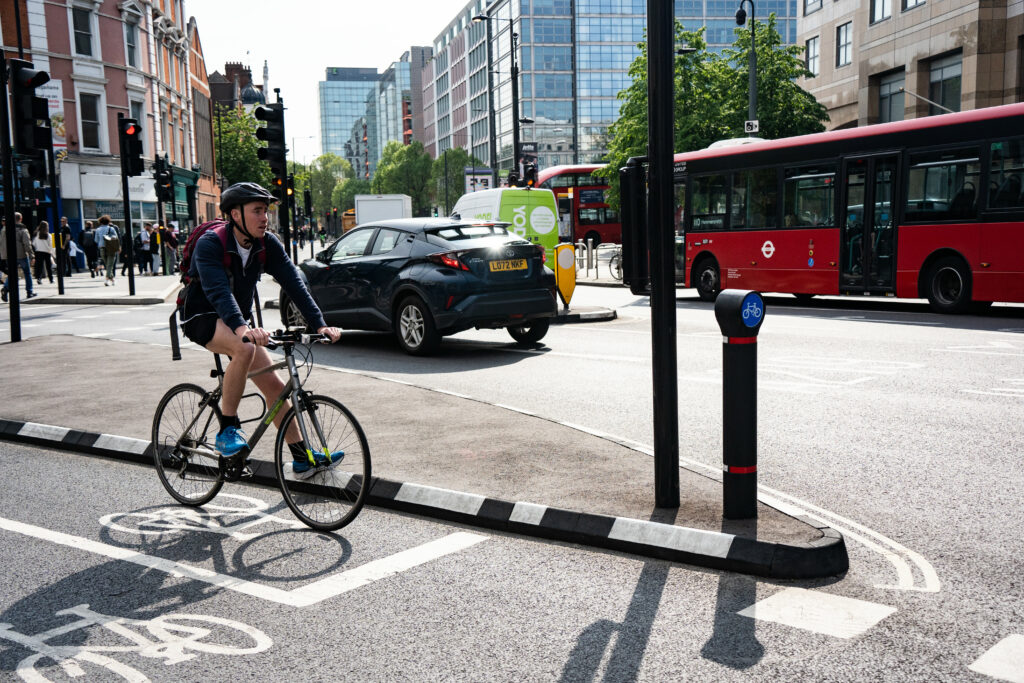SYSTRA offers a broad range of services to help local authorities, developers and planners create attractive walking and cycling networks that encourage greater adoption of active modes of travel – to reduce carbon emissions and improve health and well-being.
Creating healthier, more sustainable travel opportunities
Encouraging greater uptake of cycling and walking is a key element in the drive towards more sustainable, low-carbon, low-impact transport systems. Transport planning authorities and local councils are prioritising the development of local cycling and walking infrastructure, but need expert support on evaluating the impact and effectiveness of different schemes.
Planners need access to data on existing walking and cycling patterns, and insights into the impact of any infrastructure changes on the uptake of these active travel modes. They also need to balance the benefits of increasing cycle and walking routes with the interests of stakeholders, who may object to the reallocation of road space or the creation of low-traffic neighbourhoods.
At SYSTRA, we have a successful track record of helping clients develop pedestrian and cycling schemes that encourage active travel, based on robust modelling using the latest tools, combined with our own expert insights.
our experience
Discover how SYSTRA provides expert insight and advice to support decision making, policy development and strategy.

SYSTRA supports the implementation of cycling and walking schemes, from modelling and forecasting to scheme design, stakeholder consultation and business case development.
Active travel schemes that work for everyone
Our active transport specialists are responsible for many innovative pedestrian and cycling projects across the UK, supporting a diverse range of public and private sector clients. We have a deep understanding of the latest active travel guidelines, trends and policies. To support policy priorities, we apply the most appropriate methods and modelling techniques to assess the impacts and costs associated with different active travel interventions.
We advise clients on how to evaluate or justify different active travel schemes. We advise on how to influence behavioural change towards more active modes, and measure the impacts of different schemes post implementation. Our modelling capabilities enable us to predict the likely usage of different facilities, such as cycle parking provision, to inform the design of those facilities.
Cycling scheme modelling and appraisal
We support the development of cycling schemes and infrastructure using a range of widely available tools, such as the UK Propensity to Cycle Tool (PCT) and Active Mode Appraisal Toolkit (AMAT). For more detailed and accurate analysis and forecasting, we can apply our own robust assessments and modelling capabilities.
Our specialists were responsible for developing the cycling network model for London (Cynemon), which estimates cyclist routes, journey times and flows at a strategic level across London. This tool is now widely used to support cycling scheme and policy appraisal. We can apply our expertise to produce localised predictions of cycle usage for any client, to support cycling scheme evaluation and business case development.
Understanding pedestrian flow, interaction and movement
To support the creation of improved walking routes, we offer expertise in static and dynamic pedestrian modelling, using a range of bespoke software packages. We use these tools to analyse pedestrian movement, interactions, flow, comfort and congestion for a range of different pedestrianisation schemes. These could include building design and redevelopment projects, station gate line installations, multi-modal interchanges, public realm enhancements and wayfinding schemes.
Our analysis helps clients to fully understand the pedestrian flow implications of any new schemes, taking into account accessibility and evacuation requirements.

areas of expertise
We apply our skills to evaluate permanent adjustments to the urban environment, as well as temporary pedestrianisation arrangements for major events.
- Building design – we help to optimise the internal layout and design of buildings, whether new or existing.
- Gating studies – analysis and recommendations on the optimal installation of ticket gate lines at stations, stadiums and other crowded places.
- Multi-modal interactions – we carry out studies of the interactions between users of different transport modes in multi-modal spaces.
- Static analysis – to assess different aspects of pedestrian movement.
- Model audit – to ensure the models being used offer an accurate and fair representation of proposed scenarios.
- Wayfinding – testing the impacts of different approaches to wayfinding and developing appropriate strategies.
Microsimulation for active travel scheme modelling
We have the expertise to help clients understand the impacts of active travel schemes on the wider road network, using microsimulation tools, such as Paramics, Vissim and Aimsun. These provide visual representations of the operation and impact of different cycling and pedestrianisation schemes to assist decision makers.
Microsimulation is the most detailed form of modelling, providing digital representations of how people and vehicles move between origins and destinations within a defined space. Pedestrian and cycling outputs can include Level of Service (LOS), travel times, identification of pinch points, flow throughput, flow density and waiting times.
The visualisations and videos can provide a detailed understanding of different schemes, such as road space reallocations or low-traffic zones. They are excellent tools for stakeholder engagement – helping to demonstrate the benefits of new schemes and overcome objections.
How can our experts help?
you may also like

Find out what its like to work at SYSTRA, rewards, benefits and about different career pathways including apprenticeships and graduate opportunities.
 Australia
Australia  Brazil
Brazil  Canada
Canada  China
China  Denmark
Denmark  France
France  India
India  Indonesia
Indonesia  Ireland
Ireland  Italy
Italy  Malaysia
Malaysia  New Zealand
New Zealand  Norway
Norway  Poland
Poland  Saudi Arabia
Saudi Arabia  Singapore
Singapore  South Korea
South Korea  Sweden
Sweden  Taiwan
Taiwan  Thailand
Thailand  United States
United States  Vietnam
Vietnam 

